Contemporary Branding Issues of Durex in the Vietnamese Market
VerifiedAdded on 2021/05/25
|12
|5835
|462
Report
AI Summary
This academic report delves into the contemporary branding challenges faced by Durex in the Vietnamese market. It begins with an introduction highlighting Durex's global success and its branding strategies. The report then presents a detailed situation analysis of the Vietnamese market, including demographic data, cultural norms, and the fragmented sexual education landscape, emphasizing the need for safe sex practices. A critical literature review follows, exploring key concepts such as brand meaning, brand resonance, and Customer-Based Brand Equity (CBBE) model. The report applies the CBBE model to Durex, analyzing its brand identity, meaning, consumer response, and relationship, and offering recommendations for enhancing brand resonance and equity within the Vietnamese market. The analysis includes the challenges related to social taboos surrounding sex and the importance of effective marketing campaigns to increase condom usage. The report emphasizes the need for Durex to position itself not only as a provider of safe sex products but also as a sexual health expert and a friend to its consumers.
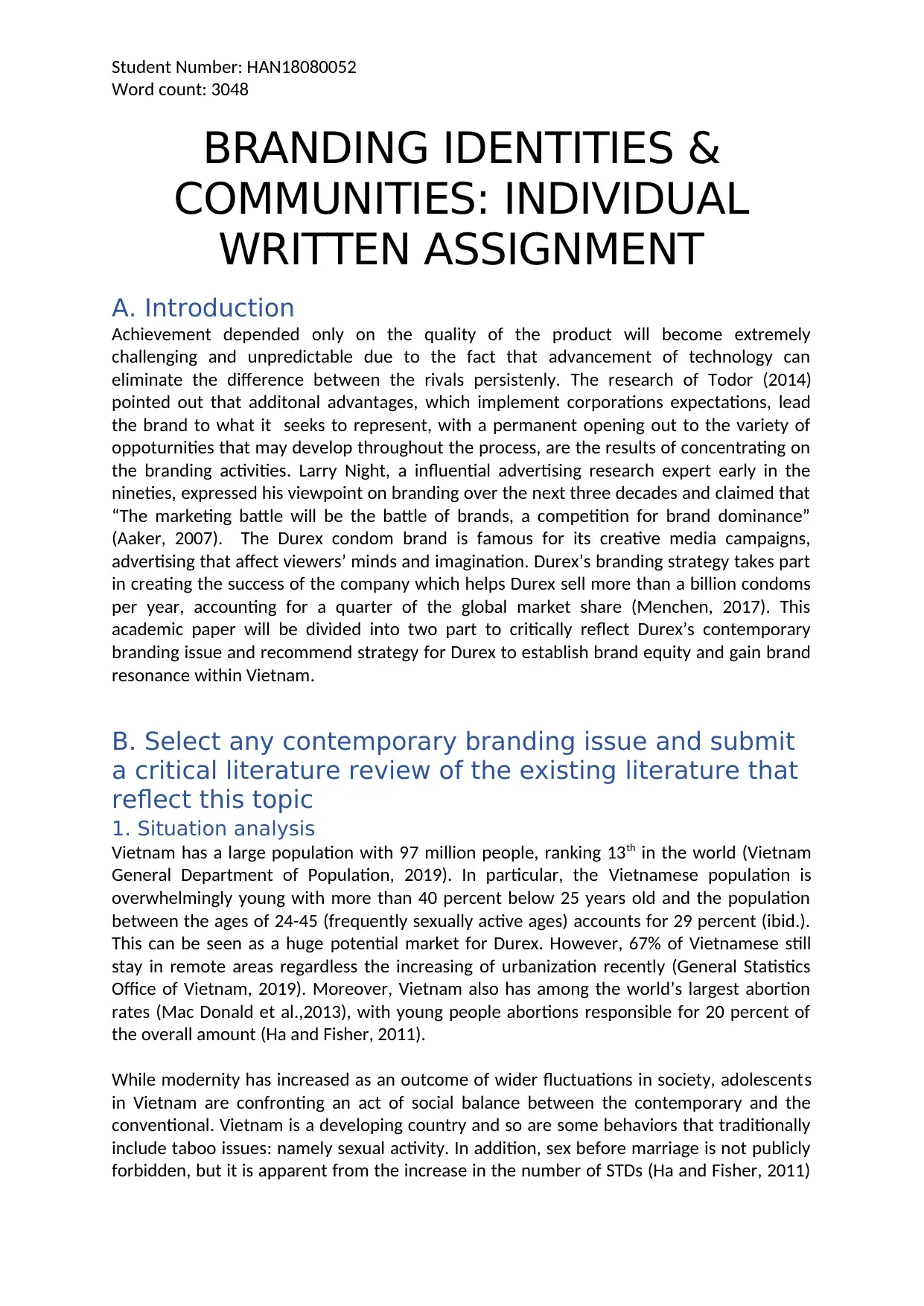
Student Number: HAN18080052
Word count: 3048
BRANDING IDENTITIES &
COMMUNITIES: INDIVIDUAL
WRITTEN ASSIGNMENT
A. Introduction
Achievement depended only on the quality of the product will become extremely
challenging and unpredictable due to the fact that advancement of technology can
eliminate the difference between the rivals persistenly. The research of Todor (2014)
pointed out that additonal advantages, which implement corporations expectations, lead
the brand to what it seeks to represent, with a permanent opening out to the variety of
oppoturnities that may develop throughout the process, are the results of concentrating on
the branding activities. Larry Night, a influential advertising research expert early in the
nineties, expressed his viewpoint on branding over the next three decades and claimed that
“The marketing battle will be the battle of brands, a competition for brand dominance”
(Aaker, 2007). The Durex condom brand is famous for its creative media campaigns,
advertising that affect viewers’ minds and imagination. Durex’s branding strategy takes part
in creating the success of the company which helps Durex sell more than a billion condoms
per year, accounting for a quarter of the global market share (Menchen, 2017). This
academic paper will be divided into two part to critically reflect Durex’s contemporary
branding issue and recommend strategy for Durex to establish brand equity and gain brand
resonance within Vietnam.
B. Select any contemporary branding issue and submit
a critical literature review of the existing literature that
reflect this topic
1. Situation analysis
Vietnam has a large population with 97 million people, ranking 13th in the world (Vietnam
General Department of Population, 2019). In particular, the Vietnamese population is
overwhelmingly young with more than 40 percent below 25 years old and the population
between the ages of 24-45 (frequently sexually active ages) accounts for 29 percent (ibid.).
This can be seen as a huge potential market for Durex. However, 67% of Vietnamese still
stay in remote areas regardless the increasing of urbanization recently (General Statistics
Office of Vietnam, 2019). Moreover, Vietnam also has among the world’s largest abortion
rates (Mac Donald et al.,2013), with young people abortions responsible for 20 percent of
the overall amount (Ha and Fisher, 2011).
While modernity has increased as an outcome of wider fluctuations in society, adolescents
in Vietnam are confronting an act of social balance between the contemporary and the
conventional. Vietnam is a developing country and so are some behaviors that traditionally
include taboo issues: namely sexual activity. In addition, sex before marriage is not publicly
forbidden, but it is apparent from the increase in the number of STDs (Ha and Fisher, 2011)
Word count: 3048
BRANDING IDENTITIES &
COMMUNITIES: INDIVIDUAL
WRITTEN ASSIGNMENT
A. Introduction
Achievement depended only on the quality of the product will become extremely
challenging and unpredictable due to the fact that advancement of technology can
eliminate the difference between the rivals persistenly. The research of Todor (2014)
pointed out that additonal advantages, which implement corporations expectations, lead
the brand to what it seeks to represent, with a permanent opening out to the variety of
oppoturnities that may develop throughout the process, are the results of concentrating on
the branding activities. Larry Night, a influential advertising research expert early in the
nineties, expressed his viewpoint on branding over the next three decades and claimed that
“The marketing battle will be the battle of brands, a competition for brand dominance”
(Aaker, 2007). The Durex condom brand is famous for its creative media campaigns,
advertising that affect viewers’ minds and imagination. Durex’s branding strategy takes part
in creating the success of the company which helps Durex sell more than a billion condoms
per year, accounting for a quarter of the global market share (Menchen, 2017). This
academic paper will be divided into two part to critically reflect Durex’s contemporary
branding issue and recommend strategy for Durex to establish brand equity and gain brand
resonance within Vietnam.
B. Select any contemporary branding issue and submit
a critical literature review of the existing literature that
reflect this topic
1. Situation analysis
Vietnam has a large population with 97 million people, ranking 13th in the world (Vietnam
General Department of Population, 2019). In particular, the Vietnamese population is
overwhelmingly young with more than 40 percent below 25 years old and the population
between the ages of 24-45 (frequently sexually active ages) accounts for 29 percent (ibid.).
This can be seen as a huge potential market for Durex. However, 67% of Vietnamese still
stay in remote areas regardless the increasing of urbanization recently (General Statistics
Office of Vietnam, 2019). Moreover, Vietnam also has among the world’s largest abortion
rates (Mac Donald et al.,2013), with young people abortions responsible for 20 percent of
the overall amount (Ha and Fisher, 2011).
While modernity has increased as an outcome of wider fluctuations in society, adolescents
in Vietnam are confronting an act of social balance between the contemporary and the
conventional. Vietnam is a developing country and so are some behaviors that traditionally
include taboo issues: namely sexual activity. In addition, sex before marriage is not publicly
forbidden, but it is apparent from the increase in the number of STDs (Ha and Fisher, 2011)
Paraphrase This Document
Need a fresh take? Get an instant paraphrase of this document with our AI Paraphraser
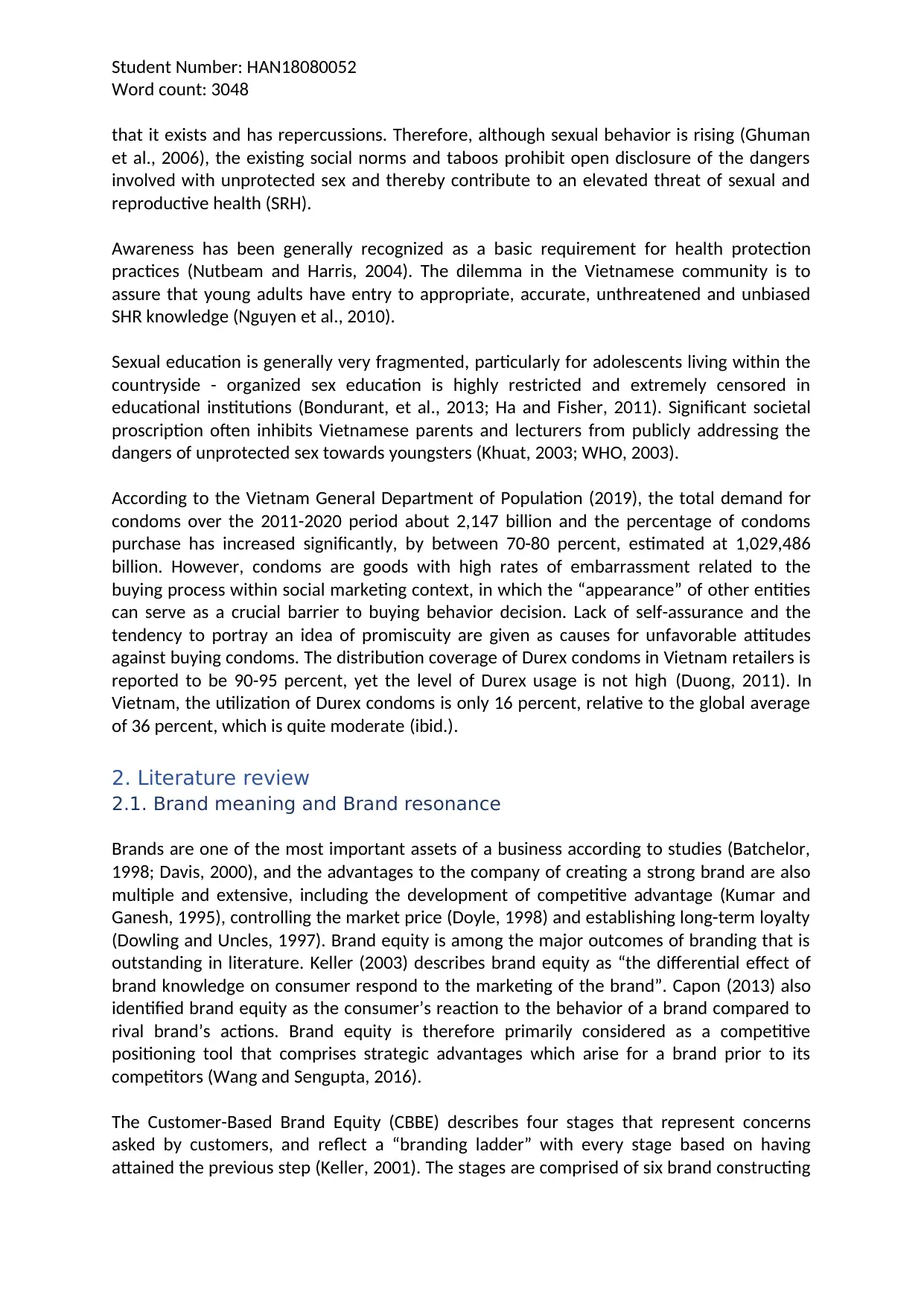
Student Number: HAN18080052
Word count: 3048
that it exists and has repercussions. Therefore, although sexual behavior is rising (Ghuman
et al., 2006), the existing social norms and taboos prohibit open disclosure of the dangers
involved with unprotected sex and thereby contribute to an elevated threat of sexual and
reproductive health (SRH).
Awareness has been generally recognized as a basic requirement for health protection
practices (Nutbeam and Harris, 2004). The dilemma in the Vietnamese community is to
assure that young adults have entry to appropriate, accurate, unthreatened and unbiased
SHR knowledge (Nguyen et al., 2010).
Sexual education is generally very fragmented, particularly for adolescents living within the
countryside - organized sex education is highly restricted and extremely censored in
educational institutions (Bondurant, et al., 2013; Ha and Fisher, 2011). Significant societal
proscription often inhibits Vietnamese parents and lecturers from publicly addressing the
dangers of unprotected sex towards youngsters (Khuat, 2003; WHO, 2003).
According to the Vietnam General Department of Population (2019), the total demand for
condoms over the 2011-2020 period about 2,147 billion and the percentage of condoms
purchase has increased significantly, by between 70-80 percent, estimated at 1,029,486
billion. However, condoms are goods with high rates of embarrassment related to the
buying process within social marketing context, in which the “appearance” of other entities
can serve as a crucial barrier to buying behavior decision. Lack of self-assurance and the
tendency to portray an idea of promiscuity are given as causes for unfavorable attitudes
against buying condoms. The distribution coverage of Durex condoms in Vietnam retailers is
reported to be 90-95 percent, yet the level of Durex usage is not high (Duong, 2011). In
Vietnam, the utilization of Durex condoms is only 16 percent, relative to the global average
of 36 percent, which is quite moderate (ibid.).
2. Literature review
2.1. Brand meaning and Brand resonance
Brands are one of the most important assets of a business according to studies (Batchelor,
1998; Davis, 2000), and the advantages to the company of creating a strong brand are also
multiple and extensive, including the development of competitive advantage (Kumar and
Ganesh, 1995), controlling the market price (Doyle, 1998) and establishing long-term loyalty
(Dowling and Uncles, 1997). Brand equity is among the major outcomes of branding that is
outstanding in literature. Keller (2003) describes brand equity as “the differential effect of
brand knowledge on consumer respond to the marketing of the brand”. Capon (2013) also
identified brand equity as the consumer’s reaction to the behavior of a brand compared to
rival brand’s actions. Brand equity is therefore primarily considered as a competitive
positioning tool that comprises strategic advantages which arise for a brand prior to its
competitors (Wang and Sengupta, 2016).
The Customer-Based Brand Equity (CBBE) describes four stages that represent concerns
asked by customers, and reflect a “branding ladder” with every stage based on having
attained the previous step (Keller, 2001). The stages are comprised of six brand constructing
Word count: 3048
that it exists and has repercussions. Therefore, although sexual behavior is rising (Ghuman
et al., 2006), the existing social norms and taboos prohibit open disclosure of the dangers
involved with unprotected sex and thereby contribute to an elevated threat of sexual and
reproductive health (SRH).
Awareness has been generally recognized as a basic requirement for health protection
practices (Nutbeam and Harris, 2004). The dilemma in the Vietnamese community is to
assure that young adults have entry to appropriate, accurate, unthreatened and unbiased
SHR knowledge (Nguyen et al., 2010).
Sexual education is generally very fragmented, particularly for adolescents living within the
countryside - organized sex education is highly restricted and extremely censored in
educational institutions (Bondurant, et al., 2013; Ha and Fisher, 2011). Significant societal
proscription often inhibits Vietnamese parents and lecturers from publicly addressing the
dangers of unprotected sex towards youngsters (Khuat, 2003; WHO, 2003).
According to the Vietnam General Department of Population (2019), the total demand for
condoms over the 2011-2020 period about 2,147 billion and the percentage of condoms
purchase has increased significantly, by between 70-80 percent, estimated at 1,029,486
billion. However, condoms are goods with high rates of embarrassment related to the
buying process within social marketing context, in which the “appearance” of other entities
can serve as a crucial barrier to buying behavior decision. Lack of self-assurance and the
tendency to portray an idea of promiscuity are given as causes for unfavorable attitudes
against buying condoms. The distribution coverage of Durex condoms in Vietnam retailers is
reported to be 90-95 percent, yet the level of Durex usage is not high (Duong, 2011). In
Vietnam, the utilization of Durex condoms is only 16 percent, relative to the global average
of 36 percent, which is quite moderate (ibid.).
2. Literature review
2.1. Brand meaning and Brand resonance
Brands are one of the most important assets of a business according to studies (Batchelor,
1998; Davis, 2000), and the advantages to the company of creating a strong brand are also
multiple and extensive, including the development of competitive advantage (Kumar and
Ganesh, 1995), controlling the market price (Doyle, 1998) and establishing long-term loyalty
(Dowling and Uncles, 1997). Brand equity is among the major outcomes of branding that is
outstanding in literature. Keller (2003) describes brand equity as “the differential effect of
brand knowledge on consumer respond to the marketing of the brand”. Capon (2013) also
identified brand equity as the consumer’s reaction to the behavior of a brand compared to
rival brand’s actions. Brand equity is therefore primarily considered as a competitive
positioning tool that comprises strategic advantages which arise for a brand prior to its
competitors (Wang and Sengupta, 2016).
The Customer-Based Brand Equity (CBBE) describes four stages that represent concerns
asked by customers, and reflect a “branding ladder” with every stage based on having
attained the previous step (Keller, 2001). The stages are comprised of six brand constructing
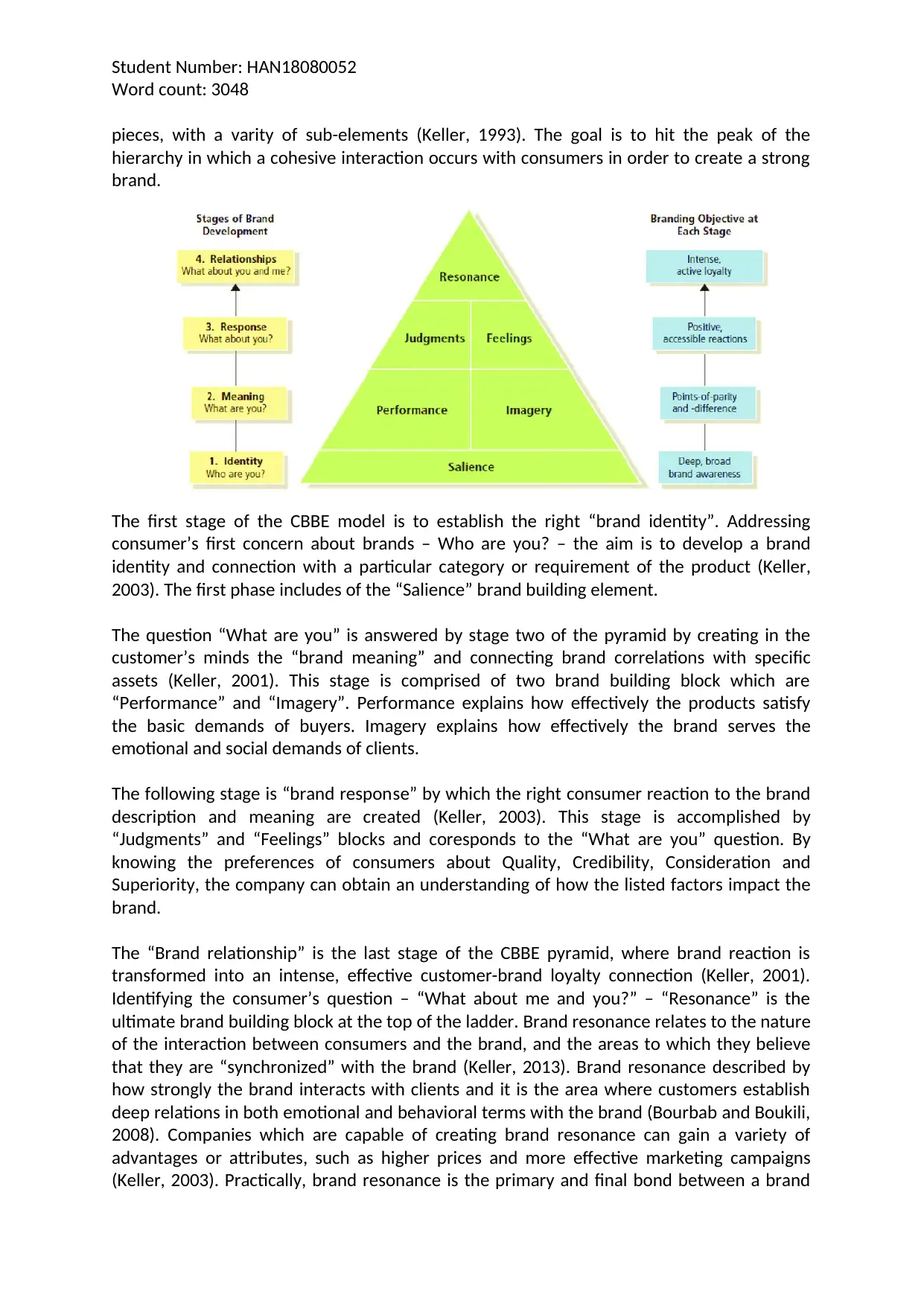
Student Number: HAN18080052
Word count: 3048
pieces, with a varity of sub-elements (Keller, 1993). The goal is to hit the peak of the
hierarchy in which a cohesive interaction occurs with consumers in order to create a strong
brand.
The first stage of the CBBE model is to establish the right “brand identity”. Addressing
consumer’s first concern about brands – Who are you? – the aim is to develop a brand
identity and connection with a particular category or requirement of the product (Keller,
2003). The first phase includes of the “Salience” brand building element.
The question “What are you” is answered by stage two of the pyramid by creating in the
customer’s minds the “brand meaning” and connecting brand correlations with specific
assets (Keller, 2001). This stage is comprised of two brand building block which are
“Performance” and “Imagery”. Performance explains how effectively the products satisfy
the basic demands of buyers. Imagery explains how effectively the brand serves the
emotional and social demands of clients.
The following stage is “brand response” by which the right consumer reaction to the brand
description and meaning are created (Keller, 2003). This stage is accomplished by
“Judgments” and “Feelings” blocks and coresponds to the “What are you” question. By
knowing the preferences of consumers about Quality, Credibility, Consideration and
Superiority, the company can obtain an understanding of how the listed factors impact the
brand.
The “Brand relationship” is the last stage of the CBBE pyramid, where brand reaction is
transformed into an intense, effective customer-brand loyalty connection (Keller, 2001).
Identifying the consumer’s question – “What about me and you?” – “Resonance” is the
ultimate brand building block at the top of the ladder. Brand resonance relates to the nature
of the interaction between consumers and the brand, and the areas to which they believe
that they are “synchronized” with the brand (Keller, 2013). Brand resonance described by
how strongly the brand interacts with clients and it is the area where customers establish
deep relations in both emotional and behavioral terms with the brand (Bourbab and Boukili,
2008). Companies which are capable of creating brand resonance can gain a variety of
advantages or attributes, such as higher prices and more effective marketing campaigns
(Keller, 2003). Practically, brand resonance is the primary and final bond between a brand
Word count: 3048
pieces, with a varity of sub-elements (Keller, 1993). The goal is to hit the peak of the
hierarchy in which a cohesive interaction occurs with consumers in order to create a strong
brand.
The first stage of the CBBE model is to establish the right “brand identity”. Addressing
consumer’s first concern about brands – Who are you? – the aim is to develop a brand
identity and connection with a particular category or requirement of the product (Keller,
2003). The first phase includes of the “Salience” brand building element.
The question “What are you” is answered by stage two of the pyramid by creating in the
customer’s minds the “brand meaning” and connecting brand correlations with specific
assets (Keller, 2001). This stage is comprised of two brand building block which are
“Performance” and “Imagery”. Performance explains how effectively the products satisfy
the basic demands of buyers. Imagery explains how effectively the brand serves the
emotional and social demands of clients.
The following stage is “brand response” by which the right consumer reaction to the brand
description and meaning are created (Keller, 2003). This stage is accomplished by
“Judgments” and “Feelings” blocks and coresponds to the “What are you” question. By
knowing the preferences of consumers about Quality, Credibility, Consideration and
Superiority, the company can obtain an understanding of how the listed factors impact the
brand.
The “Brand relationship” is the last stage of the CBBE pyramid, where brand reaction is
transformed into an intense, effective customer-brand loyalty connection (Keller, 2001).
Identifying the consumer’s question – “What about me and you?” – “Resonance” is the
ultimate brand building block at the top of the ladder. Brand resonance relates to the nature
of the interaction between consumers and the brand, and the areas to which they believe
that they are “synchronized” with the brand (Keller, 2013). Brand resonance described by
how strongly the brand interacts with clients and it is the area where customers establish
deep relations in both emotional and behavioral terms with the brand (Bourbab and Boukili,
2008). Companies which are capable of creating brand resonance can gain a variety of
advantages or attributes, such as higher prices and more effective marketing campaigns
(Keller, 2003). Practically, brand resonance is the primary and final bond between a brand
⊘ This is a preview!⊘
Do you want full access?
Subscribe today to unlock all pages.

Trusted by 1+ million students worldwide
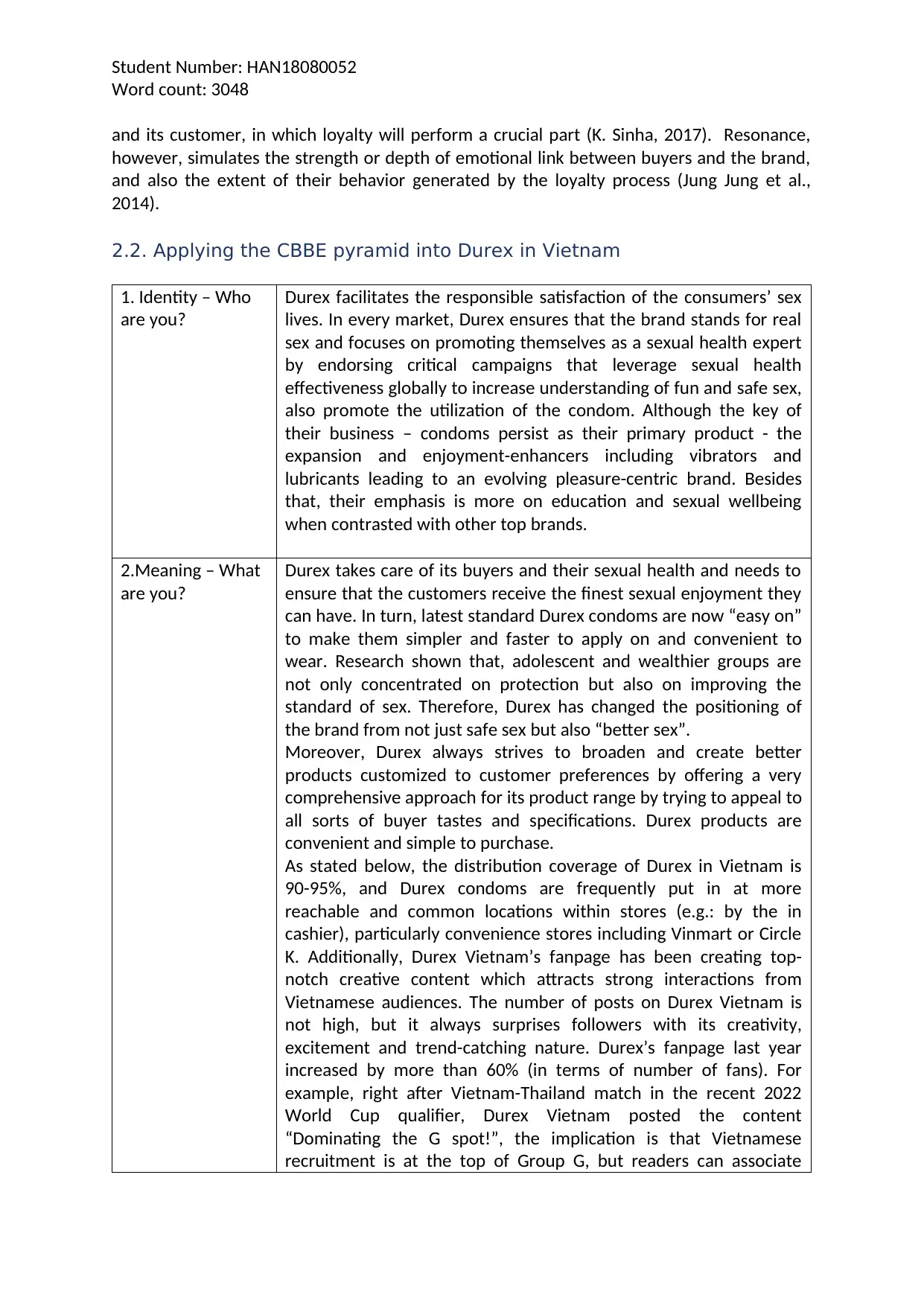
Student Number: HAN18080052
Word count: 3048
and its customer, in which loyalty will perform a crucial part (K. Sinha, 2017). Resonance,
however, simulates the strength or depth of emotional link between buyers and the brand,
and also the extent of their behavior generated by the loyalty process (Jung Jung et al.,
2014).
2.2. Applying the CBBE pyramid into Durex in Vietnam
1. Identity – Who
are you?
Durex facilitates the responsible satisfaction of the consumers’ sex
lives. In every market, Durex ensures that the brand stands for real
sex and focuses on promoting themselves as a sexual health expert
by endorsing critical campaigns that leverage sexual health
effectiveness globally to increase understanding of fun and safe sex,
also promote the utilization of the condom. Although the key of
their business – condoms persist as their primary product - the
expansion and enjoyment-enhancers including vibrators and
lubricants leading to an evolving pleasure-centric brand. Besides
that, their emphasis is more on education and sexual wellbeing
when contrasted with other top brands.
2.Meaning – What
are you?
Durex takes care of its buyers and their sexual health and needs to
ensure that the customers receive the finest sexual enjoyment they
can have. In turn, latest standard Durex condoms are now “easy on”
to make them simpler and faster to apply on and convenient to
wear. Research shown that, adolescent and wealthier groups are
not only concentrated on protection but also on improving the
standard of sex. Therefore, Durex has changed the positioning of
the brand from not just safe sex but also “better sex”.
Moreover, Durex always strives to broaden and create better
products customized to customer preferences by offering a very
comprehensive approach for its product range by trying to appeal to
all sorts of buyer tastes and specifications. Durex products are
convenient and simple to purchase.
As stated below, the distribution coverage of Durex in Vietnam is
90-95%, and Durex condoms are frequently put in at more
reachable and common locations within stores (e.g.: by the in
cashier), particularly convenience stores including Vinmart or Circle
K. Additionally, Durex Vietnam’s fanpage has been creating top-
notch creative content which attracts strong interactions from
Vietnamese audiences. The number of posts on Durex Vietnam is
not high, but it always surprises followers with its creativity,
excitement and trend-catching nature. Durex’s fanpage last year
increased by more than 60% (in terms of number of fans). For
example, right after Vietnam-Thailand match in the recent 2022
World Cup qualifier, Durex Vietnam posted the content
“Dominating the G spot!”, the implication is that Vietnamese
recruitment is at the top of Group G, but readers can associate
Word count: 3048
and its customer, in which loyalty will perform a crucial part (K. Sinha, 2017). Resonance,
however, simulates the strength or depth of emotional link between buyers and the brand,
and also the extent of their behavior generated by the loyalty process (Jung Jung et al.,
2014).
2.2. Applying the CBBE pyramid into Durex in Vietnam
1. Identity – Who
are you?
Durex facilitates the responsible satisfaction of the consumers’ sex
lives. In every market, Durex ensures that the brand stands for real
sex and focuses on promoting themselves as a sexual health expert
by endorsing critical campaigns that leverage sexual health
effectiveness globally to increase understanding of fun and safe sex,
also promote the utilization of the condom. Although the key of
their business – condoms persist as their primary product - the
expansion and enjoyment-enhancers including vibrators and
lubricants leading to an evolving pleasure-centric brand. Besides
that, their emphasis is more on education and sexual wellbeing
when contrasted with other top brands.
2.Meaning – What
are you?
Durex takes care of its buyers and their sexual health and needs to
ensure that the customers receive the finest sexual enjoyment they
can have. In turn, latest standard Durex condoms are now “easy on”
to make them simpler and faster to apply on and convenient to
wear. Research shown that, adolescent and wealthier groups are
not only concentrated on protection but also on improving the
standard of sex. Therefore, Durex has changed the positioning of
the brand from not just safe sex but also “better sex”.
Moreover, Durex always strives to broaden and create better
products customized to customer preferences by offering a very
comprehensive approach for its product range by trying to appeal to
all sorts of buyer tastes and specifications. Durex products are
convenient and simple to purchase.
As stated below, the distribution coverage of Durex in Vietnam is
90-95%, and Durex condoms are frequently put in at more
reachable and common locations within stores (e.g.: by the in
cashier), particularly convenience stores including Vinmart or Circle
K. Additionally, Durex Vietnam’s fanpage has been creating top-
notch creative content which attracts strong interactions from
Vietnamese audiences. The number of posts on Durex Vietnam is
not high, but it always surprises followers with its creativity,
excitement and trend-catching nature. Durex’s fanpage last year
increased by more than 60% (in terms of number of fans). For
example, right after Vietnam-Thailand match in the recent 2022
World Cup qualifier, Durex Vietnam posted the content
“Dominating the G spot!”, the implication is that Vietnamese
recruitment is at the top of Group G, but readers can associate
Paraphrase This Document
Need a fresh take? Get an instant paraphrase of this document with our AI Paraphraser
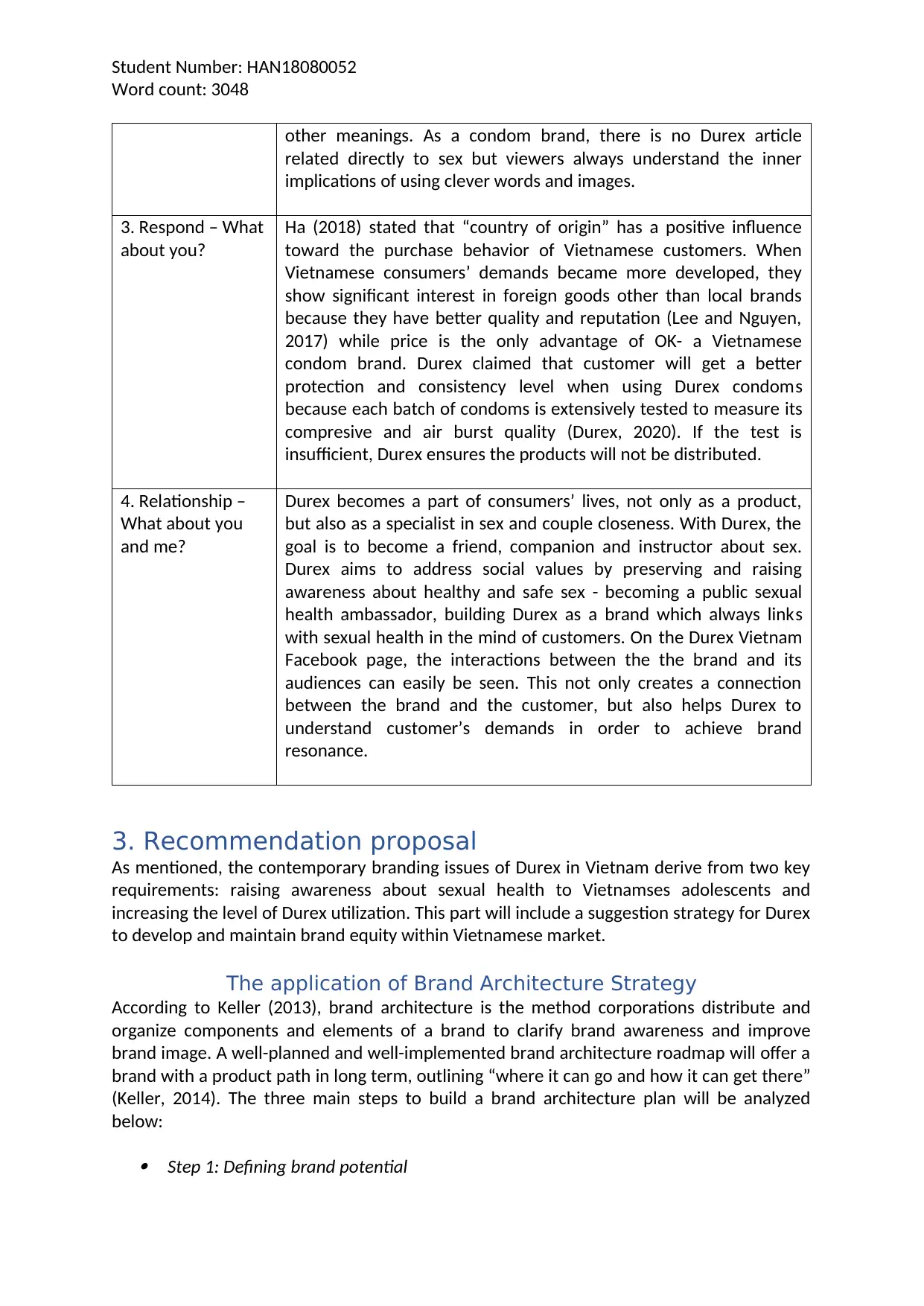
Student Number: HAN18080052
Word count: 3048
other meanings. As a condom brand, there is no Durex article
related directly to sex but viewers always understand the inner
implications of using clever words and images.
3. Respond – What
about you?
Ha (2018) stated that “country of origin” has a positive influence
toward the purchase behavior of Vietnamese customers. When
Vietnamese consumers’ demands became more developed, they
show significant interest in foreign goods other than local brands
because they have better quality and reputation (Lee and Nguyen,
2017) while price is the only advantage of OK- a Vietnamese
condom brand. Durex claimed that customer will get a better
protection and consistency level when using Durex condoms
because each batch of condoms is extensively tested to measure its
compresive and air burst quality (Durex, 2020). If the test is
insufficient, Durex ensures the products will not be distributed.
4. Relationship –
What about you
and me?
Durex becomes a part of consumers’ lives, not only as a product,
but also as a specialist in sex and couple closeness. With Durex, the
goal is to become a friend, companion and instructor about sex.
Durex aims to address social values by preserving and raising
awareness about healthy and safe sex - becoming a public sexual
health ambassador, building Durex as a brand which always links
with sexual health in the mind of customers. On the Durex Vietnam
Facebook page, the interactions between the the brand and its
audiences can easily be seen. This not only creates a connection
between the brand and the customer, but also helps Durex to
understand customer’s demands in order to achieve brand
resonance.
3. Recommendation proposal
As mentioned, the contemporary branding issues of Durex in Vietnam derive from two key
requirements: raising awareness about sexual health to Vietnamses adolescents and
increasing the level of Durex utilization. This part will include a suggestion strategy for Durex
to develop and maintain brand equity within Vietnamese market.
The application of Brand Architecture Strategy
According to Keller (2013), brand architecture is the method corporations distribute and
organize components and elements of a brand to clarify brand awareness and improve
brand image. A well-planned and well-implemented brand architecture roadmap will offer a
brand with a product path in long term, outlining “where it can go and how it can get there”
(Keller, 2014). The three main steps to build a brand architecture plan will be analyzed
below: Step 1: Defining brand potential
Word count: 3048
other meanings. As a condom brand, there is no Durex article
related directly to sex but viewers always understand the inner
implications of using clever words and images.
3. Respond – What
about you?
Ha (2018) stated that “country of origin” has a positive influence
toward the purchase behavior of Vietnamese customers. When
Vietnamese consumers’ demands became more developed, they
show significant interest in foreign goods other than local brands
because they have better quality and reputation (Lee and Nguyen,
2017) while price is the only advantage of OK- a Vietnamese
condom brand. Durex claimed that customer will get a better
protection and consistency level when using Durex condoms
because each batch of condoms is extensively tested to measure its
compresive and air burst quality (Durex, 2020). If the test is
insufficient, Durex ensures the products will not be distributed.
4. Relationship –
What about you
and me?
Durex becomes a part of consumers’ lives, not only as a product,
but also as a specialist in sex and couple closeness. With Durex, the
goal is to become a friend, companion and instructor about sex.
Durex aims to address social values by preserving and raising
awareness about healthy and safe sex - becoming a public sexual
health ambassador, building Durex as a brand which always links
with sexual health in the mind of customers. On the Durex Vietnam
Facebook page, the interactions between the the brand and its
audiences can easily be seen. This not only creates a connection
between the brand and the customer, but also helps Durex to
understand customer’s demands in order to achieve brand
resonance.
3. Recommendation proposal
As mentioned, the contemporary branding issues of Durex in Vietnam derive from two key
requirements: raising awareness about sexual health to Vietnamses adolescents and
increasing the level of Durex utilization. This part will include a suggestion strategy for Durex
to develop and maintain brand equity within Vietnamese market.
The application of Brand Architecture Strategy
According to Keller (2013), brand architecture is the method corporations distribute and
organize components and elements of a brand to clarify brand awareness and improve
brand image. A well-planned and well-implemented brand architecture roadmap will offer a
brand with a product path in long term, outlining “where it can go and how it can get there”
(Keller, 2014). The three main steps to build a brand architecture plan will be analyzed
below: Step 1: Defining brand potential
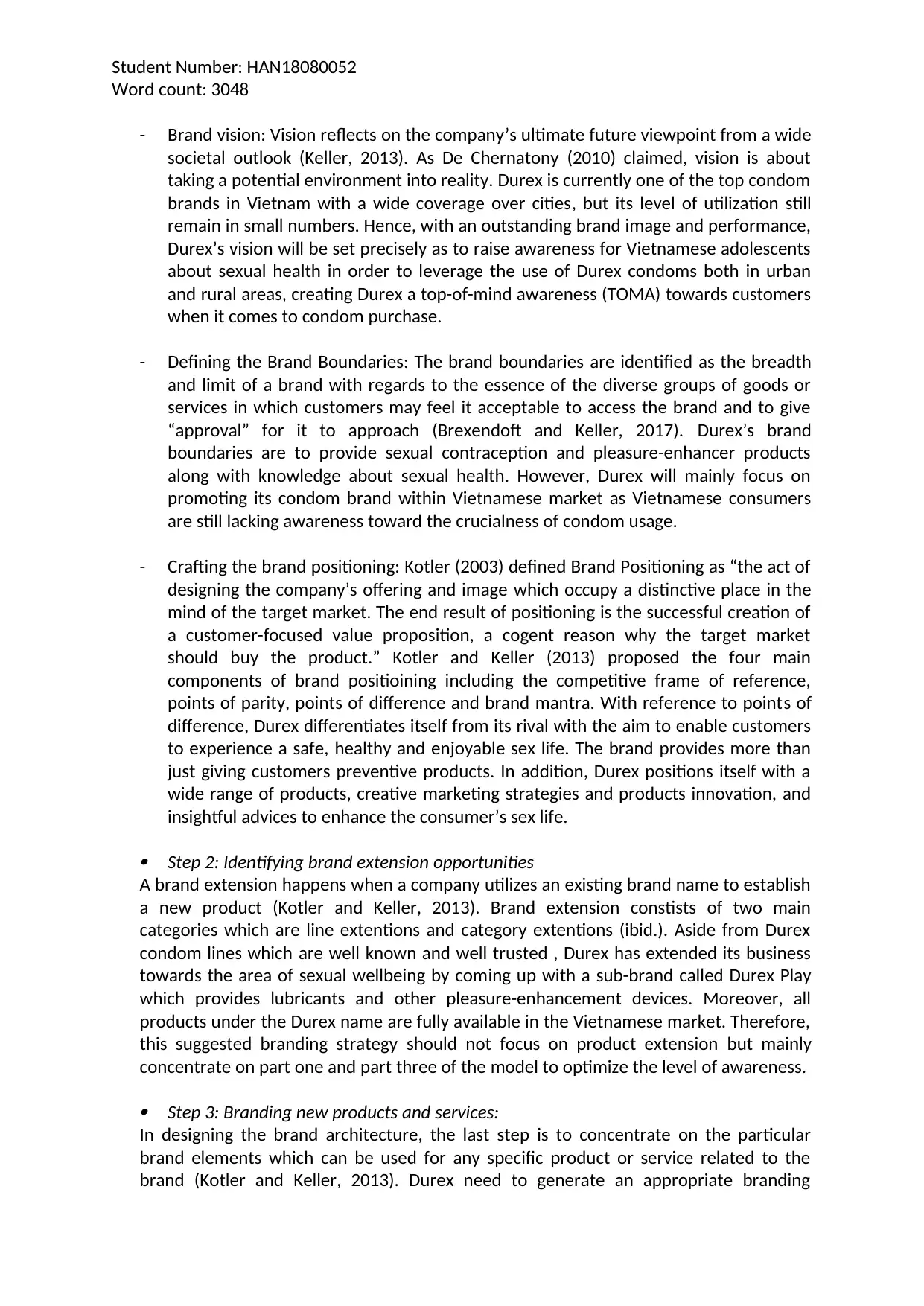
Student Number: HAN18080052
Word count: 3048
- Brand vision: Vision reflects on the company’s ultimate future viewpoint from a wide
societal outlook (Keller, 2013). As De Chernatony (2010) claimed, vision is about
taking a potential environment into reality. Durex is currently one of the top condom
brands in Vietnam with a wide coverage over cities, but its level of utilization still
remain in small numbers. Hence, with an outstanding brand image and performance,
Durex’s vision will be set precisely as to raise awareness for Vietnamese adolescents
about sexual health in order to leverage the use of Durex condoms both in urban
and rural areas, creating Durex a top-of-mind awareness (TOMA) towards customers
when it comes to condom purchase.
- Defining the Brand Boundaries: The brand boundaries are identified as the breadth
and limit of a brand with regards to the essence of the diverse groups of goods or
services in which customers may feel it acceptable to access the brand and to give
“approval” for it to approach (Brexendoft and Keller, 2017). Durex’s brand
boundaries are to provide sexual contraception and pleasure-enhancer products
along with knowledge about sexual health. However, Durex will mainly focus on
promoting its condom brand within Vietnamese market as Vietnamese consumers
are still lacking awareness toward the crucialness of condom usage.
- Crafting the brand positioning: Kotler (2003) defined Brand Positioning as “the act of
designing the company’s offering and image which occupy a distinctive place in the
mind of the target market. The end result of positioning is the successful creation of
a customer-focused value proposition, a cogent reason why the target market
should buy the product.” Kotler and Keller (2013) proposed the four main
components of brand positioining including the competitive frame of reference,
points of parity, points of difference and brand mantra. With reference to points of
difference, Durex differentiates itself from its rival with the aim to enable customers
to experience a safe, healthy and enjoyable sex life. The brand provides more than
just giving customers preventive products. In addition, Durex positions itself with a
wide range of products, creative marketing strategies and products innovation, and
insightful advices to enhance the consumer’s sex life. Step 2: Identifying brand extension opportunities
A brand extension happens when a company utilizes an existing brand name to establish
a new product (Kotler and Keller, 2013). Brand extension constists of two main
categories which are line extentions and category extentions (ibid.). Aside from Durex
condom lines which are well known and well trusted , Durex has extended its business
towards the area of sexual wellbeing by coming up with a sub-brand called Durex Play
which provides lubricants and other pleasure-enhancement devices. Moreover, all
products under the Durex name are fully available in the Vietnamese market. Therefore,
this suggested branding strategy should not focus on product extension but mainly
concentrate on part one and part three of the model to optimize the level of awareness. Step 3: Branding new products and services:
In designing the brand architecture, the last step is to concentrate on the particular
brand elements which can be used for any specific product or service related to the
brand (Kotler and Keller, 2013). Durex need to generate an appropriate branding
Word count: 3048
- Brand vision: Vision reflects on the company’s ultimate future viewpoint from a wide
societal outlook (Keller, 2013). As De Chernatony (2010) claimed, vision is about
taking a potential environment into reality. Durex is currently one of the top condom
brands in Vietnam with a wide coverage over cities, but its level of utilization still
remain in small numbers. Hence, with an outstanding brand image and performance,
Durex’s vision will be set precisely as to raise awareness for Vietnamese adolescents
about sexual health in order to leverage the use of Durex condoms both in urban
and rural areas, creating Durex a top-of-mind awareness (TOMA) towards customers
when it comes to condom purchase.
- Defining the Brand Boundaries: The brand boundaries are identified as the breadth
and limit of a brand with regards to the essence of the diverse groups of goods or
services in which customers may feel it acceptable to access the brand and to give
“approval” for it to approach (Brexendoft and Keller, 2017). Durex’s brand
boundaries are to provide sexual contraception and pleasure-enhancer products
along with knowledge about sexual health. However, Durex will mainly focus on
promoting its condom brand within Vietnamese market as Vietnamese consumers
are still lacking awareness toward the crucialness of condom usage.
- Crafting the brand positioning: Kotler (2003) defined Brand Positioning as “the act of
designing the company’s offering and image which occupy a distinctive place in the
mind of the target market. The end result of positioning is the successful creation of
a customer-focused value proposition, a cogent reason why the target market
should buy the product.” Kotler and Keller (2013) proposed the four main
components of brand positioining including the competitive frame of reference,
points of parity, points of difference and brand mantra. With reference to points of
difference, Durex differentiates itself from its rival with the aim to enable customers
to experience a safe, healthy and enjoyable sex life. The brand provides more than
just giving customers preventive products. In addition, Durex positions itself with a
wide range of products, creative marketing strategies and products innovation, and
insightful advices to enhance the consumer’s sex life. Step 2: Identifying brand extension opportunities
A brand extension happens when a company utilizes an existing brand name to establish
a new product (Kotler and Keller, 2013). Brand extension constists of two main
categories which are line extentions and category extentions (ibid.). Aside from Durex
condom lines which are well known and well trusted , Durex has extended its business
towards the area of sexual wellbeing by coming up with a sub-brand called Durex Play
which provides lubricants and other pleasure-enhancement devices. Moreover, all
products under the Durex name are fully available in the Vietnamese market. Therefore,
this suggested branding strategy should not focus on product extension but mainly
concentrate on part one and part three of the model to optimize the level of awareness. Step 3: Branding new products and services:
In designing the brand architecture, the last step is to concentrate on the particular
brand elements which can be used for any specific product or service related to the
brand (Kotler and Keller, 2013). Durex need to generate an appropriate branding
⊘ This is a preview!⊘
Do you want full access?
Subscribe today to unlock all pages.

Trusted by 1+ million students worldwide
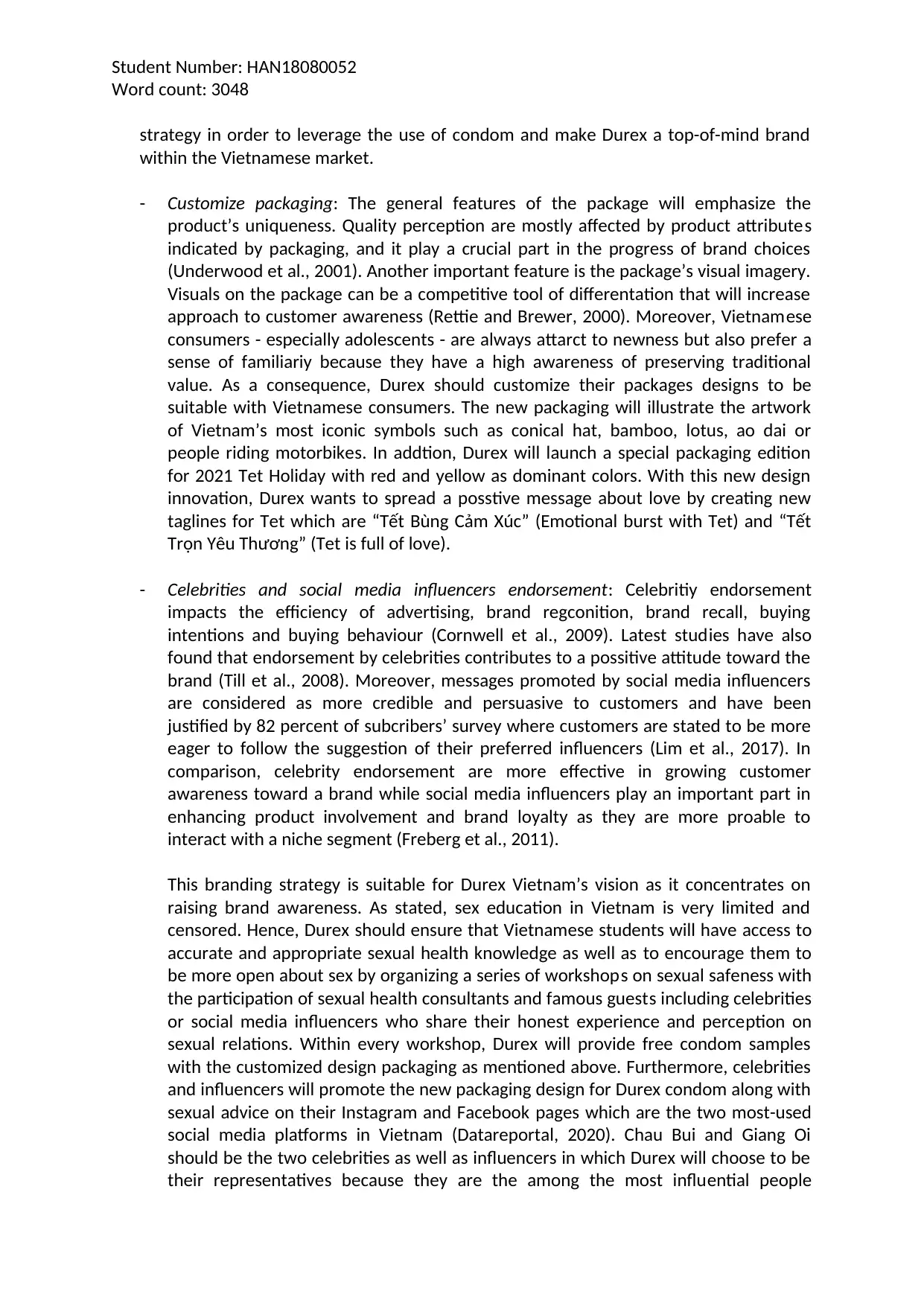
Student Number: HAN18080052
Word count: 3048
strategy in order to leverage the use of condom and make Durex a top-of-mind brand
within the Vietnamese market.
- Customize packaging: The general features of the package will emphasize the
product’s uniqueness. Quality perception are mostly affected by product attributes
indicated by packaging, and it play a crucial part in the progress of brand choices
(Underwood et al., 2001). Another important feature is the package’s visual imagery.
Visuals on the package can be a competitive tool of differentation that will increase
approach to customer awareness (Rettie and Brewer, 2000). Moreover, Vietnamese
consumers - especially adolescents - are always attarct to newness but also prefer a
sense of familiariy because they have a high awareness of preserving traditional
value. As a consequence, Durex should customize their packages designs to be
suitable with Vietnamese consumers. The new packaging will illustrate the artwork
of Vietnam’s most iconic symbols such as conical hat, bamboo, lotus, ao dai or
people riding motorbikes. In addtion, Durex will launch a special packaging edition
for 2021 Tet Holiday with red and yellow as dominant colors. With this new design
innovation, Durex wants to spread a posstive message about love by creating new
taglines for Tet which are “Tết Bùng Cảm Xúc” (Emotional burst with Tet) and “Tết
Trọn Yêu Thương” (Tet is full of love).
- Celebrities and social media influencers endorsement: Celebritiy endorsement
impacts the efficiency of advertising, brand regconition, brand recall, buying
intentions and buying behaviour (Cornwell et al., 2009). Latest studies have also
found that endorsement by celebrities contributes to a possitive attitude toward the
brand (Till et al., 2008). Moreover, messages promoted by social media influencers
are considered as more credible and persuasive to customers and have been
justified by 82 percent of subcribers’ survey where customers are stated to be more
eager to follow the suggestion of their preferred influencers (Lim et al., 2017). In
comparison, celebrity endorsement are more effective in growing customer
awareness toward a brand while social media influencers play an important part in
enhancing product involvement and brand loyalty as they are more proable to
interact with a niche segment (Freberg et al., 2011).
This branding strategy is suitable for Durex Vietnam’s vision as it concentrates on
raising brand awareness. As stated, sex education in Vietnam is very limited and
censored. Hence, Durex should ensure that Vietnamese students will have access to
accurate and appropriate sexual health knowledge as well as to encourage them to
be more open about sex by organizing a series of workshops on sexual safeness with
the participation of sexual health consultants and famous guests including celebrities
or social media influencers who share their honest experience and perception on
sexual relations. Within every workshop, Durex will provide free condom samples
with the customized design packaging as mentioned above. Furthermore, celebrities
and influencers will promote the new packaging design for Durex condom along with
sexual advice on their Instagram and Facebook pages which are the two most-used
social media platforms in Vietnam (Datareportal, 2020). Chau Bui and Giang Oi
should be the two celebrities as well as influencers in which Durex will choose to be
their representatives because they are the among the most influential people
Word count: 3048
strategy in order to leverage the use of condom and make Durex a top-of-mind brand
within the Vietnamese market.
- Customize packaging: The general features of the package will emphasize the
product’s uniqueness. Quality perception are mostly affected by product attributes
indicated by packaging, and it play a crucial part in the progress of brand choices
(Underwood et al., 2001). Another important feature is the package’s visual imagery.
Visuals on the package can be a competitive tool of differentation that will increase
approach to customer awareness (Rettie and Brewer, 2000). Moreover, Vietnamese
consumers - especially adolescents - are always attarct to newness but also prefer a
sense of familiariy because they have a high awareness of preserving traditional
value. As a consequence, Durex should customize their packages designs to be
suitable with Vietnamese consumers. The new packaging will illustrate the artwork
of Vietnam’s most iconic symbols such as conical hat, bamboo, lotus, ao dai or
people riding motorbikes. In addtion, Durex will launch a special packaging edition
for 2021 Tet Holiday with red and yellow as dominant colors. With this new design
innovation, Durex wants to spread a posstive message about love by creating new
taglines for Tet which are “Tết Bùng Cảm Xúc” (Emotional burst with Tet) and “Tết
Trọn Yêu Thương” (Tet is full of love).
- Celebrities and social media influencers endorsement: Celebritiy endorsement
impacts the efficiency of advertising, brand regconition, brand recall, buying
intentions and buying behaviour (Cornwell et al., 2009). Latest studies have also
found that endorsement by celebrities contributes to a possitive attitude toward the
brand (Till et al., 2008). Moreover, messages promoted by social media influencers
are considered as more credible and persuasive to customers and have been
justified by 82 percent of subcribers’ survey where customers are stated to be more
eager to follow the suggestion of their preferred influencers (Lim et al., 2017). In
comparison, celebrity endorsement are more effective in growing customer
awareness toward a brand while social media influencers play an important part in
enhancing product involvement and brand loyalty as they are more proable to
interact with a niche segment (Freberg et al., 2011).
This branding strategy is suitable for Durex Vietnam’s vision as it concentrates on
raising brand awareness. As stated, sex education in Vietnam is very limited and
censored. Hence, Durex should ensure that Vietnamese students will have access to
accurate and appropriate sexual health knowledge as well as to encourage them to
be more open about sex by organizing a series of workshops on sexual safeness with
the participation of sexual health consultants and famous guests including celebrities
or social media influencers who share their honest experience and perception on
sexual relations. Within every workshop, Durex will provide free condom samples
with the customized design packaging as mentioned above. Furthermore, celebrities
and influencers will promote the new packaging design for Durex condom along with
sexual advice on their Instagram and Facebook pages which are the two most-used
social media platforms in Vietnam (Datareportal, 2020). Chau Bui and Giang Oi
should be the two celebrities as well as influencers in which Durex will choose to be
their representatives because they are the among the most influential people
Paraphrase This Document
Need a fresh take? Get an instant paraphrase of this document with our AI Paraphraser
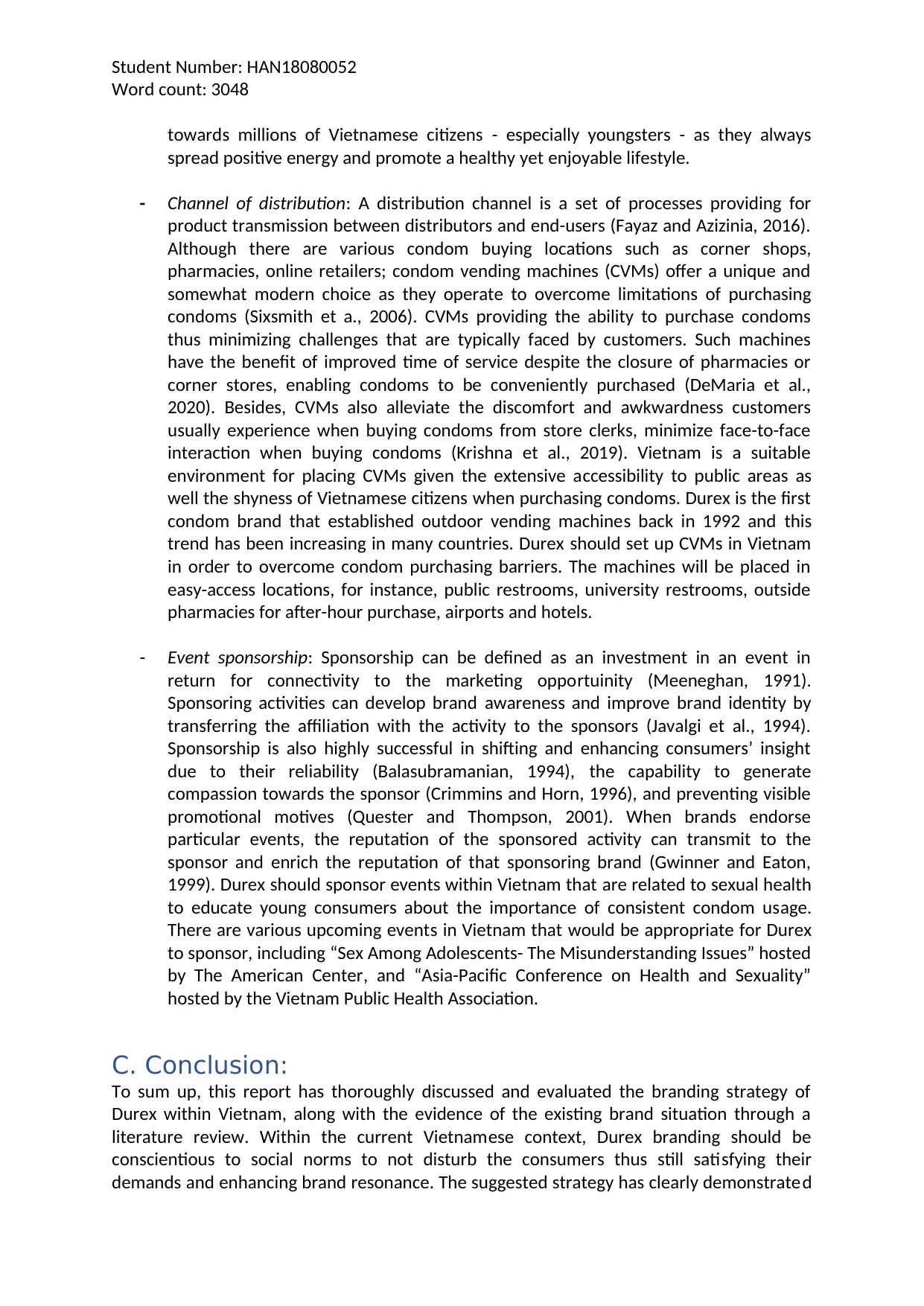
Student Number: HAN18080052
Word count: 3048
towards millions of Vietnamese citizens - especially youngsters - as they always
spread positive energy and promote a healthy yet enjoyable lifestyle.
- Channel of distribution: A distribution channel is a set of processes providing for
product transmission between distributors and end-users (Fayaz and Azizinia, 2016).
Although there are various condom buying locations such as corner shops,
pharmacies, online retailers; condom vending machines (CVMs) offer a unique and
somewhat modern choice as they operate to overcome limitations of purchasing
condoms (Sixsmith et a., 2006). CVMs providing the ability to purchase condoms
thus minimizing challenges that are typically faced by customers. Such machines
have the benefit of improved time of service despite the closure of pharmacies or
corner stores, enabling condoms to be conveniently purchased (DeMaria et al.,
2020). Besides, CVMs also alleviate the discomfort and awkwardness customers
usually experience when buying condoms from store clerks, minimize face-to-face
interaction when buying condoms (Krishna et al., 2019). Vietnam is a suitable
environment for placing CVMs given the extensive accessibility to public areas as
well the shyness of Vietnamese citizens when purchasing condoms. Durex is the first
condom brand that established outdoor vending machines back in 1992 and this
trend has been increasing in many countries. Durex should set up CVMs in Vietnam
in order to overcome condom purchasing barriers. The machines will be placed in
easy-access locations, for instance, public restrooms, university restrooms, outside
pharmacies for after-hour purchase, airports and hotels.
- Event sponsorship: Sponsorship can be defined as an investment in an event in
return for connectivity to the marketing opportuinity (Meeneghan, 1991).
Sponsoring activities can develop brand awareness and improve brand identity by
transferring the affiliation with the activity to the sponsors (Javalgi et al., 1994).
Sponsorship is also highly successful in shifting and enhancing consumers’ insight
due to their reliability (Balasubramanian, 1994), the capability to generate
compassion towards the sponsor (Crimmins and Horn, 1996), and preventing visible
promotional motives (Quester and Thompson, 2001). When brands endorse
particular events, the reputation of the sponsored activity can transmit to the
sponsor and enrich the reputation of that sponsoring brand (Gwinner and Eaton,
1999). Durex should sponsor events within Vietnam that are related to sexual health
to educate young consumers about the importance of consistent condom usage.
There are various upcoming events in Vietnam that would be appropriate for Durex
to sponsor, including “Sex Among Adolescents- The Misunderstanding Issues” hosted
by The American Center, and “Asia-Pacific Conference on Health and Sexuality”
hosted by the Vietnam Public Health Association.
C. Conclusion:
To sum up, this report has thoroughly discussed and evaluated the branding strategy of
Durex within Vietnam, along with the evidence of the existing brand situation through a
literature review. Within the current Vietnamese context, Durex branding should be
conscientious to social norms to not disturb the consumers thus still satisfying their
demands and enhancing brand resonance. The suggested strategy has clearly demonstrated
Word count: 3048
towards millions of Vietnamese citizens - especially youngsters - as they always
spread positive energy and promote a healthy yet enjoyable lifestyle.
- Channel of distribution: A distribution channel is a set of processes providing for
product transmission between distributors and end-users (Fayaz and Azizinia, 2016).
Although there are various condom buying locations such as corner shops,
pharmacies, online retailers; condom vending machines (CVMs) offer a unique and
somewhat modern choice as they operate to overcome limitations of purchasing
condoms (Sixsmith et a., 2006). CVMs providing the ability to purchase condoms
thus minimizing challenges that are typically faced by customers. Such machines
have the benefit of improved time of service despite the closure of pharmacies or
corner stores, enabling condoms to be conveniently purchased (DeMaria et al.,
2020). Besides, CVMs also alleviate the discomfort and awkwardness customers
usually experience when buying condoms from store clerks, minimize face-to-face
interaction when buying condoms (Krishna et al., 2019). Vietnam is a suitable
environment for placing CVMs given the extensive accessibility to public areas as
well the shyness of Vietnamese citizens when purchasing condoms. Durex is the first
condom brand that established outdoor vending machines back in 1992 and this
trend has been increasing in many countries. Durex should set up CVMs in Vietnam
in order to overcome condom purchasing barriers. The machines will be placed in
easy-access locations, for instance, public restrooms, university restrooms, outside
pharmacies for after-hour purchase, airports and hotels.
- Event sponsorship: Sponsorship can be defined as an investment in an event in
return for connectivity to the marketing opportuinity (Meeneghan, 1991).
Sponsoring activities can develop brand awareness and improve brand identity by
transferring the affiliation with the activity to the sponsors (Javalgi et al., 1994).
Sponsorship is also highly successful in shifting and enhancing consumers’ insight
due to their reliability (Balasubramanian, 1994), the capability to generate
compassion towards the sponsor (Crimmins and Horn, 1996), and preventing visible
promotional motives (Quester and Thompson, 2001). When brands endorse
particular events, the reputation of the sponsored activity can transmit to the
sponsor and enrich the reputation of that sponsoring brand (Gwinner and Eaton,
1999). Durex should sponsor events within Vietnam that are related to sexual health
to educate young consumers about the importance of consistent condom usage.
There are various upcoming events in Vietnam that would be appropriate for Durex
to sponsor, including “Sex Among Adolescents- The Misunderstanding Issues” hosted
by The American Center, and “Asia-Pacific Conference on Health and Sexuality”
hosted by the Vietnam Public Health Association.
C. Conclusion:
To sum up, this report has thoroughly discussed and evaluated the branding strategy of
Durex within Vietnam, along with the evidence of the existing brand situation through a
literature review. Within the current Vietnamese context, Durex branding should be
conscientious to social norms to not disturb the consumers thus still satisfying their
demands and enhancing brand resonance. The suggested strategy has clearly demonstrated
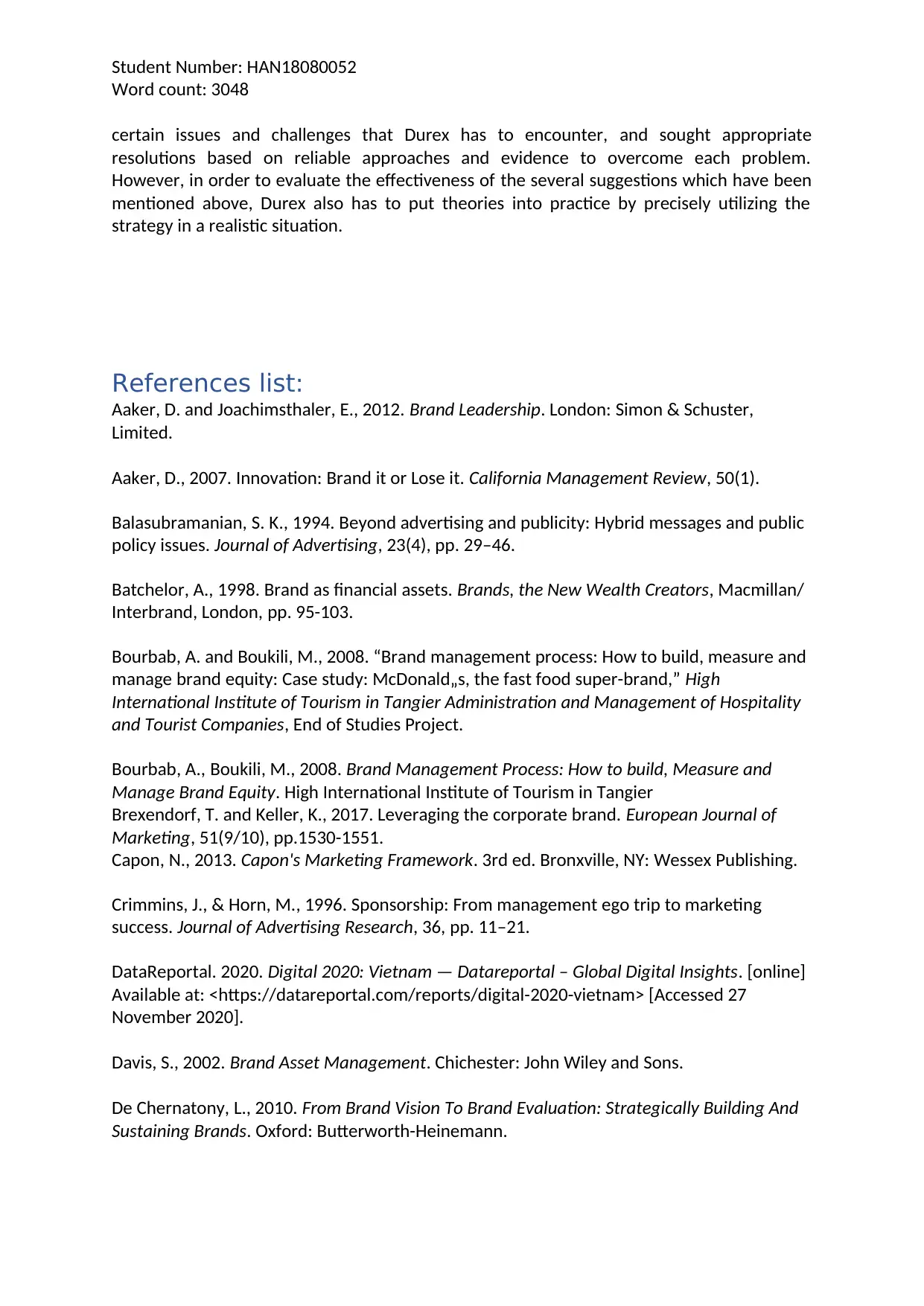
Student Number: HAN18080052
Word count: 3048
certain issues and challenges that Durex has to encounter, and sought appropriate
resolutions based on reliable approaches and evidence to overcome each problem.
However, in order to evaluate the effectiveness of the several suggestions which have been
mentioned above, Durex also has to put theories into practice by precisely utilizing the
strategy in a realistic situation.
References list:
Aaker, D. and Joachimsthaler, E., 2012. Brand Leadership. London: Simon & Schuster,
Limited.
Aaker, D., 2007. Innovation: Brand it or Lose it. California Management Review, 50(1).
Balasubramanian, S. K., 1994. Beyond advertising and publicity: Hybrid messages and public
policy issues. Journal of Advertising, 23(4), pp. 29–46.
Batchelor, A., 1998. Brand as financial assets. Brands, the New Wealth Creators, Macmillan/
Interbrand, London, pp. 95-103.
Bourbab, A. and Boukili, M., 2008. “Brand management process: How to build, measure and
manage brand equity: Case study: McDonald„s, the fast food super-brand,” High
International Institute of Tourism in Tangier Administration and Management of Hospitality
and Tourist Companies, End of Studies Project.
Bourbab, A., Boukili, M., 2008. Brand Management Process: How to build, Measure and
Manage Brand Equity. High International Institute of Tourism in Tangier
Brexendorf, T. and Keller, K., 2017. Leveraging the corporate brand. European Journal of
Marketing, 51(9/10), pp.1530-1551.
Capon, N., 2013. Capon's Marketing Framework. 3rd ed. Bronxville, NY: Wessex Publishing.
Crimmins, J., & Horn, M., 1996. Sponsorship: From management ego trip to marketing
success. Journal of Advertising Research, 36, pp. 11–21.
DataReportal. 2020. Digital 2020: Vietnam — Datareportal – Global Digital Insights. [online]
Available at: <https://datareportal.com/reports/digital-2020-vietnam> [Accessed 27
November 2020].
Davis, S., 2002. Brand Asset Management. Chichester: John Wiley and Sons.
De Chernatony, L., 2010. From Brand Vision To Brand Evaluation: Strategically Building And
Sustaining Brands. Oxford: Butterworth-Heinemann.
Word count: 3048
certain issues and challenges that Durex has to encounter, and sought appropriate
resolutions based on reliable approaches and evidence to overcome each problem.
However, in order to evaluate the effectiveness of the several suggestions which have been
mentioned above, Durex also has to put theories into practice by precisely utilizing the
strategy in a realistic situation.
References list:
Aaker, D. and Joachimsthaler, E., 2012. Brand Leadership. London: Simon & Schuster,
Limited.
Aaker, D., 2007. Innovation: Brand it or Lose it. California Management Review, 50(1).
Balasubramanian, S. K., 1994. Beyond advertising and publicity: Hybrid messages and public
policy issues. Journal of Advertising, 23(4), pp. 29–46.
Batchelor, A., 1998. Brand as financial assets. Brands, the New Wealth Creators, Macmillan/
Interbrand, London, pp. 95-103.
Bourbab, A. and Boukili, M., 2008. “Brand management process: How to build, measure and
manage brand equity: Case study: McDonald„s, the fast food super-brand,” High
International Institute of Tourism in Tangier Administration and Management of Hospitality
and Tourist Companies, End of Studies Project.
Bourbab, A., Boukili, M., 2008. Brand Management Process: How to build, Measure and
Manage Brand Equity. High International Institute of Tourism in Tangier
Brexendorf, T. and Keller, K., 2017. Leveraging the corporate brand. European Journal of
Marketing, 51(9/10), pp.1530-1551.
Capon, N., 2013. Capon's Marketing Framework. 3rd ed. Bronxville, NY: Wessex Publishing.
Crimmins, J., & Horn, M., 1996. Sponsorship: From management ego trip to marketing
success. Journal of Advertising Research, 36, pp. 11–21.
DataReportal. 2020. Digital 2020: Vietnam — Datareportal – Global Digital Insights. [online]
Available at: <https://datareportal.com/reports/digital-2020-vietnam> [Accessed 27
November 2020].
Davis, S., 2002. Brand Asset Management. Chichester: John Wiley and Sons.
De Chernatony, L., 2010. From Brand Vision To Brand Evaluation: Strategically Building And
Sustaining Brands. Oxford: Butterworth-Heinemann.
⊘ This is a preview!⊘
Do you want full access?
Subscribe today to unlock all pages.

Trusted by 1+ million students worldwide
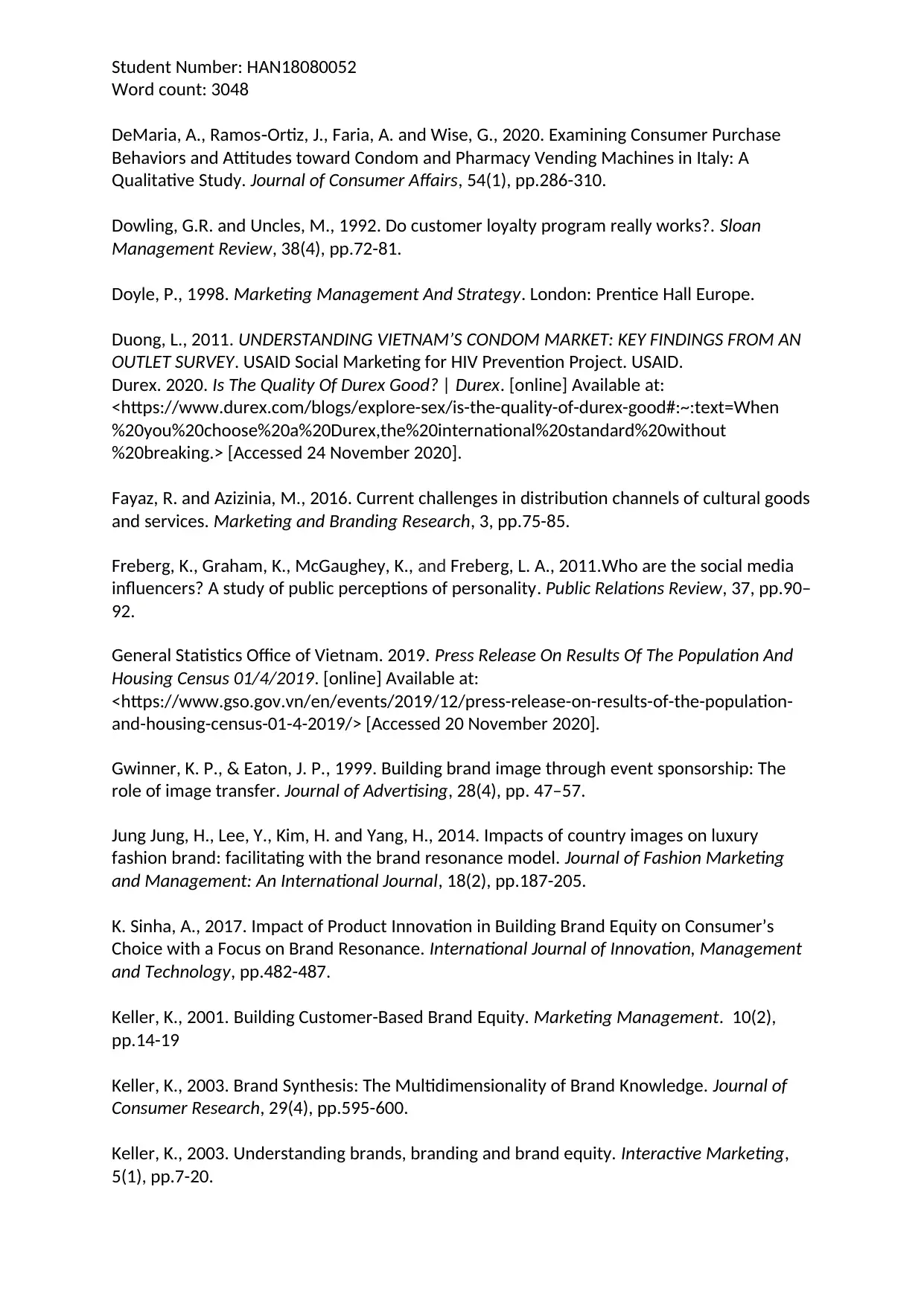
Student Number: HAN18080052
Word count: 3048
DeMaria, A., Ramos Ortiz, J., Faria, A. and Wise, G., 2020. Examining Consumer Purchase‐
Behaviors and Attitudes toward Condom and Pharmacy Vending Machines in Italy: A
Qualitative Study. Journal of Consumer Affairs, 54(1), pp.286-310.
Dowling, G.R. and Uncles, M., 1992. Do customer loyalty program really works?. Sloan
Management Review, 38(4), pp.72-81.
Doyle, P., 1998. Marketing Management And Strategy. London: Prentice Hall Europe.
Duong, L., 2011. UNDERSTANDING VIETNAM’S CONDOM MARKET: KEY FINDINGS FROM AN
OUTLET SURVEY. USAID Social Marketing for HIV Prevention Project. USAID.
Durex. 2020. Is The Quality Of Durex Good? | Durex. [online] Available at:
<https://www.durex.com/blogs/explore-sex/is-the-quality-of-durex-good#:~:text=When
%20you%20choose%20a%20Durex,the%20international%20standard%20without
%20breaking.> [Accessed 24 November 2020].
Fayaz, R. and Azizinia, M., 2016. Current challenges in distribution channels of cultural goods
and services. Marketing and Branding Research, 3, pp.75-85.
Freberg, K., Graham, K., McGaughey, K., and Freberg, L. A., 2011.Who are the social media
influencers? A study of public perceptions of personality. Public Relations Review, 37, pp.90–
92.
General Statistics Office of Vietnam. 2019. Press Release On Results Of The Population And
Housing Census 01/4/2019. [online] Available at:
<https://www.gso.gov.vn/en/events/2019/12/press-release-on-results-of-the-population-
and-housing-census-01-4-2019/> [Accessed 20 November 2020].
Gwinner, K. P., & Eaton, J. P., 1999. Building brand image through event sponsorship: The
role of image transfer. Journal of Advertising, 28(4), pp. 47–57.
Jung Jung, H., Lee, Y., Kim, H. and Yang, H., 2014. Impacts of country images on luxury
fashion brand: facilitating with the brand resonance model. Journal of Fashion Marketing
and Management: An International Journal, 18(2), pp.187-205.
K. Sinha, A., 2017. Impact of Product Innovation in Building Brand Equity on Consumer’s
Choice with a Focus on Brand Resonance. International Journal of Innovation, Management
and Technology, pp.482-487.
Keller, K., 2001. Building Customer-Based Brand Equity. Marketing Management. 10(2),
pp.14-19
Keller, K., 2003. Brand Synthesis: The Multidimensionality of Brand Knowledge. Journal of
Consumer Research, 29(4), pp.595-600.
Keller, K., 2003. Understanding brands, branding and brand equity. Interactive Marketing,
5(1), pp.7-20.
Word count: 3048
DeMaria, A., Ramos Ortiz, J., Faria, A. and Wise, G., 2020. Examining Consumer Purchase‐
Behaviors and Attitudes toward Condom and Pharmacy Vending Machines in Italy: A
Qualitative Study. Journal of Consumer Affairs, 54(1), pp.286-310.
Dowling, G.R. and Uncles, M., 1992. Do customer loyalty program really works?. Sloan
Management Review, 38(4), pp.72-81.
Doyle, P., 1998. Marketing Management And Strategy. London: Prentice Hall Europe.
Duong, L., 2011. UNDERSTANDING VIETNAM’S CONDOM MARKET: KEY FINDINGS FROM AN
OUTLET SURVEY. USAID Social Marketing for HIV Prevention Project. USAID.
Durex. 2020. Is The Quality Of Durex Good? | Durex. [online] Available at:
<https://www.durex.com/blogs/explore-sex/is-the-quality-of-durex-good#:~:text=When
%20you%20choose%20a%20Durex,the%20international%20standard%20without
%20breaking.> [Accessed 24 November 2020].
Fayaz, R. and Azizinia, M., 2016. Current challenges in distribution channels of cultural goods
and services. Marketing and Branding Research, 3, pp.75-85.
Freberg, K., Graham, K., McGaughey, K., and Freberg, L. A., 2011.Who are the social media
influencers? A study of public perceptions of personality. Public Relations Review, 37, pp.90–
92.
General Statistics Office of Vietnam. 2019. Press Release On Results Of The Population And
Housing Census 01/4/2019. [online] Available at:
<https://www.gso.gov.vn/en/events/2019/12/press-release-on-results-of-the-population-
and-housing-census-01-4-2019/> [Accessed 20 November 2020].
Gwinner, K. P., & Eaton, J. P., 1999. Building brand image through event sponsorship: The
role of image transfer. Journal of Advertising, 28(4), pp. 47–57.
Jung Jung, H., Lee, Y., Kim, H. and Yang, H., 2014. Impacts of country images on luxury
fashion brand: facilitating with the brand resonance model. Journal of Fashion Marketing
and Management: An International Journal, 18(2), pp.187-205.
K. Sinha, A., 2017. Impact of Product Innovation in Building Brand Equity on Consumer’s
Choice with a Focus on Brand Resonance. International Journal of Innovation, Management
and Technology, pp.482-487.
Keller, K., 2001. Building Customer-Based Brand Equity. Marketing Management. 10(2),
pp.14-19
Keller, K., 2003. Brand Synthesis: The Multidimensionality of Brand Knowledge. Journal of
Consumer Research, 29(4), pp.595-600.
Keller, K., 2003. Understanding brands, branding and brand equity. Interactive Marketing,
5(1), pp.7-20.
Paraphrase This Document
Need a fresh take? Get an instant paraphrase of this document with our AI Paraphraser
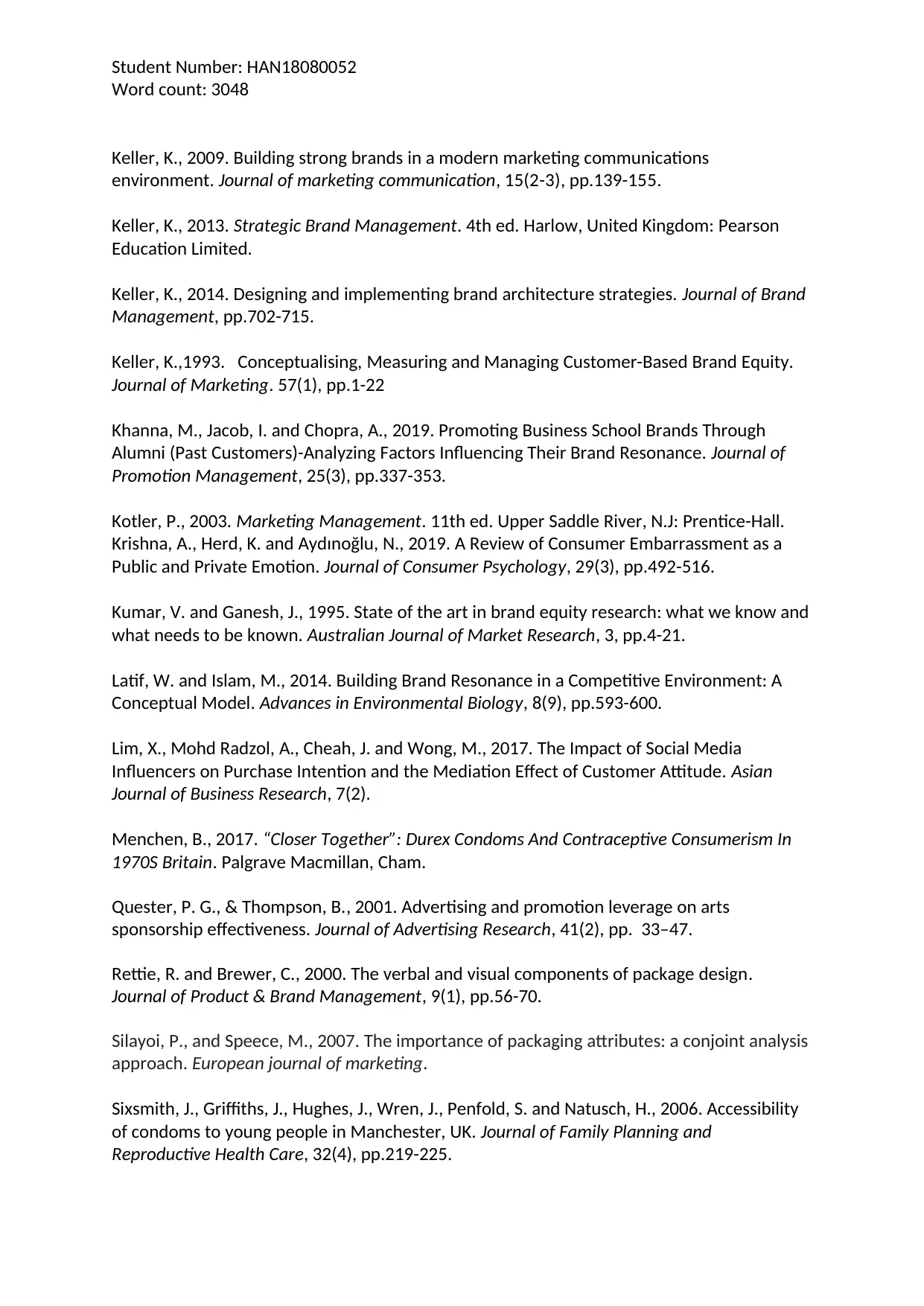
Student Number: HAN18080052
Word count: 3048
Keller, K., 2009. Building strong brands in a modern marketing communications
environment. Journal of marketing communication, 15(2-3), pp.139-155.
Keller, K., 2013. Strategic Brand Management. 4th ed. Harlow, United Kingdom: Pearson
Education Limited.
Keller, K., 2014. Designing and implementing brand architecture strategies. Journal of Brand
Management, pp.702-715.
Keller, K.,1993. Conceptualising, Measuring and Managing Customer-Based Brand Equity.
Journal of Marketing. 57(1), pp.1-22
Khanna, M., Jacob, I. and Chopra, A., 2019. Promoting Business School Brands Through
Alumni (Past Customers)-Analyzing Factors Influencing Their Brand Resonance. Journal of
Promotion Management, 25(3), pp.337-353.
Kotler, P., 2003. Marketing Management. 11th ed. Upper Saddle River, N.J: Prentice-Hall.
Krishna, A., Herd, K. and Aydınoğlu, N., 2019. A Review of Consumer Embarrassment as a
Public and Private Emotion. Journal of Consumer Psychology, 29(3), pp.492-516.
Kumar, V. and Ganesh, J., 1995. State of the art in brand equity research: what we know and
what needs to be known. Australian Journal of Market Research, 3, pp.4-21.
Latif, W. and Islam, M., 2014. Building Brand Resonance in a Competitive Environment: A
Conceptual Model. Advances in Environmental Biology, 8(9), pp.593-600.
Lim, X., Mohd Radzol, A., Cheah, J. and Wong, M., 2017. The Impact of Social Media
Influencers on Purchase Intention and the Mediation Effect of Customer Attitude. Asian
Journal of Business Research, 7(2).
Menchen, B., 2017. “Closer Together”: Durex Condoms And Contraceptive Consumerism In
1970S Britain. Palgrave Macmillan, Cham.
Quester, P. G., & Thompson, B., 2001. Advertising and promotion leverage on arts
sponsorship effectiveness. Journal of Advertising Research, 41(2), pp. 33–47.
Rettie, R. and Brewer, C., 2000. The verbal and visual components of package design.
Journal of Product & Brand Management, 9(1), pp.56-70.
Silayoi, P., and Speece, M., 2007. The importance of packaging attributes: a conjoint analysis
approach. European journal of marketing.
Sixsmith, J., Griffiths, J., Hughes, J., Wren, J., Penfold, S. and Natusch, H., 2006. Accessibility
of condoms to young people in Manchester, UK. Journal of Family Planning and
Reproductive Health Care, 32(4), pp.219-225.
Word count: 3048
Keller, K., 2009. Building strong brands in a modern marketing communications
environment. Journal of marketing communication, 15(2-3), pp.139-155.
Keller, K., 2013. Strategic Brand Management. 4th ed. Harlow, United Kingdom: Pearson
Education Limited.
Keller, K., 2014. Designing and implementing brand architecture strategies. Journal of Brand
Management, pp.702-715.
Keller, K.,1993. Conceptualising, Measuring and Managing Customer-Based Brand Equity.
Journal of Marketing. 57(1), pp.1-22
Khanna, M., Jacob, I. and Chopra, A., 2019. Promoting Business School Brands Through
Alumni (Past Customers)-Analyzing Factors Influencing Their Brand Resonance. Journal of
Promotion Management, 25(3), pp.337-353.
Kotler, P., 2003. Marketing Management. 11th ed. Upper Saddle River, N.J: Prentice-Hall.
Krishna, A., Herd, K. and Aydınoğlu, N., 2019. A Review of Consumer Embarrassment as a
Public and Private Emotion. Journal of Consumer Psychology, 29(3), pp.492-516.
Kumar, V. and Ganesh, J., 1995. State of the art in brand equity research: what we know and
what needs to be known. Australian Journal of Market Research, 3, pp.4-21.
Latif, W. and Islam, M., 2014. Building Brand Resonance in a Competitive Environment: A
Conceptual Model. Advances in Environmental Biology, 8(9), pp.593-600.
Lim, X., Mohd Radzol, A., Cheah, J. and Wong, M., 2017. The Impact of Social Media
Influencers on Purchase Intention and the Mediation Effect of Customer Attitude. Asian
Journal of Business Research, 7(2).
Menchen, B., 2017. “Closer Together”: Durex Condoms And Contraceptive Consumerism In
1970S Britain. Palgrave Macmillan, Cham.
Quester, P. G., & Thompson, B., 2001. Advertising and promotion leverage on arts
sponsorship effectiveness. Journal of Advertising Research, 41(2), pp. 33–47.
Rettie, R. and Brewer, C., 2000. The verbal and visual components of package design.
Journal of Product & Brand Management, 9(1), pp.56-70.
Silayoi, P., and Speece, M., 2007. The importance of packaging attributes: a conjoint analysis
approach. European journal of marketing.
Sixsmith, J., Griffiths, J., Hughes, J., Wren, J., Penfold, S. and Natusch, H., 2006. Accessibility
of condoms to young people in Manchester, UK. Journal of Family Planning and
Reproductive Health Care, 32(4), pp.219-225.
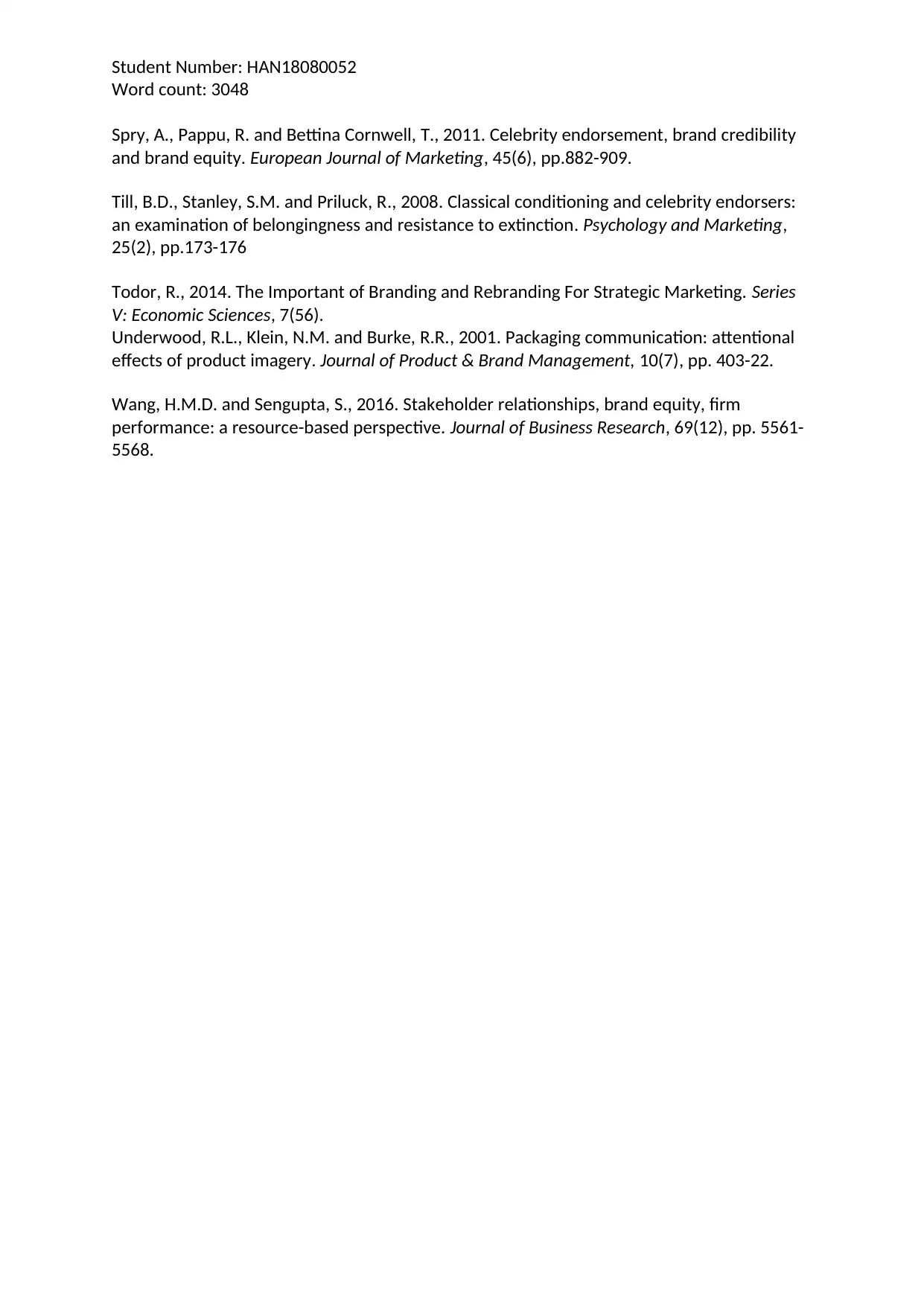
Student Number: HAN18080052
Word count: 3048
Spry, A., Pappu, R. and Bettina Cornwell, T., 2011. Celebrity endorsement, brand credibility
and brand equity. European Journal of Marketing, 45(6), pp.882-909.
Till, B.D., Stanley, S.M. and Priluck, R., 2008. Classical conditioning and celebrity endorsers:
an examination of belongingness and resistance to extinction. Psychology and Marketing,
25(2), pp.173-176
Todor, R., 2014. The Important of Branding and Rebranding For Strategic Marketing. Series
V: Economic Sciences, 7(56).
Underwood, R.L., Klein, N.M. and Burke, R.R., 2001. Packaging communication: attentional
effects of product imagery. Journal of Product & Brand Management, 10(7), pp. 403-22.
Wang, H.M.D. and Sengupta, S., 2016. Stakeholder relationships, brand equity, firm
performance: a resource-based perspective. Journal of Business Research, 69(12), pp. 5561-
5568.
Word count: 3048
Spry, A., Pappu, R. and Bettina Cornwell, T., 2011. Celebrity endorsement, brand credibility
and brand equity. European Journal of Marketing, 45(6), pp.882-909.
Till, B.D., Stanley, S.M. and Priluck, R., 2008. Classical conditioning and celebrity endorsers:
an examination of belongingness and resistance to extinction. Psychology and Marketing,
25(2), pp.173-176
Todor, R., 2014. The Important of Branding and Rebranding For Strategic Marketing. Series
V: Economic Sciences, 7(56).
Underwood, R.L., Klein, N.M. and Burke, R.R., 2001. Packaging communication: attentional
effects of product imagery. Journal of Product & Brand Management, 10(7), pp. 403-22.
Wang, H.M.D. and Sengupta, S., 2016. Stakeholder relationships, brand equity, firm
performance: a resource-based perspective. Journal of Business Research, 69(12), pp. 5561-
5568.
⊘ This is a preview!⊘
Do you want full access?
Subscribe today to unlock all pages.

Trusted by 1+ million students worldwide
1 out of 12
Your All-in-One AI-Powered Toolkit for Academic Success.
+13062052269
info@desklib.com
Available 24*7 on WhatsApp / Email
![[object Object]](/_next/static/media/star-bottom.7253800d.svg)
Unlock your academic potential
Copyright © 2020–2025 A2Z Services. All Rights Reserved. Developed and managed by ZUCOL.